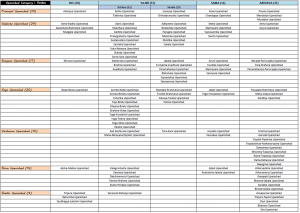The Upanishads (Sanskrit: Upaniṣads) are the ancient texts of philosophy, and commonly referred to Vedanta (the essence of Veda). The unity of Brahman (ultimate reality) and Atman (soul, self) is the core idea in all of the Upanishads.
There are 108 Upanishads are associated with the Veda.
- 10 upaniṣads are associated with the Rigveda.
- 16 upaniṣads are associated with the Samaveda.
- 19 upaniṣads are associated with the Shukla Yajurveda.
- 32 upaniṣads are associated with the Krishna Yajurveda.
- 31 upaniṣads are associated with the Atharvaveda.
<The 108 Upanishads List> Image credit. www.sohamyogastudio.org/images/veda2.png
In the present volume, there are 13 Upanishads are considered to be the most significant. They are the 10 principal Upanishads (please refer to <The 108 Upanishads List> ), plus Svetasvtara Upanishad, Kaushitaki Upanishad, and Maitrayaniya Upanishad.
Most of the texts are in poetic form, for example, the brahman is described as:
- ‘What is soundless, touchless, formless, imperishable, Likewise tasteless, constant, odorless, Without beginning, without end, higher than the great.’ (Kaṭha 3. 15.)
- ‘There the eye goes not; Speech goes not, nor the mind. We know not, we understand not. How one would teach it.’ (Kena 3.)
To unite self to the ultimate, which actually is Yoga (from the root yuj, meaning to ‘join,’ ‘yoke,’ ‘harness’), there are some practical hints, for example:
- ‘To the unity of the One goes he who knows this [i. e. that all is one]. The precept for effecting this [unity] is this: restraint of the breath, withdrawal of the senses [from objects], meditation, concentration, contemplation, absorption’ (Maitri 6. 17, 18).
- ‘By tranquility of thought. Deeds, good and evil, one destroys! With soul serene, stayed on the Soul, Delight eternal one enjoys!’(Maitri 6. 20)
The final exhortation of the Upanishads is well expressed in the following words:
- ‘Taking as a bow the great weapon of the Upanishad, One should put upon it an arrow sharpened by meditation. Stretching it with a thought directed to the essence of That, Penetrate that Imperishable as the mark, my friend. The mystic syllable Om1 is the bow. The arrow is the soul. Brahma is said to be the mark. By the undistracted man is It to be penetrated. One should come to be in It, as the arrow [in the mark].’ (Muṇḍ. 2. 2. 3-4.)
For those who are interest in reading the texts, please click here.
Wish you an unimpeded path of self-realization!
Click here for 200 hours self pace one-on-one LIVE Online YogaShe teacher training info

